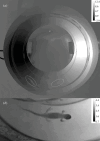Seasonal variation of behavioural thermoregulation in a fossorial salamander (Ambystoma maculatum)
- PMID: 39233724
- PMCID: PMC11371426
- DOI: 10.1098/rsos.240537
Seasonal variation of behavioural thermoregulation in a fossorial salamander (Ambystoma maculatum)
Abstract
Temperature seasonality plays a pivotal role in shaping the thermal biology of ectotherms. However, we still have a limited understanding of how ectotherms maintain thermal balance in the face of varying temperatures, especially in fossorial species. Due to thermal buffering underground, thermal ecology theory predicts relaxed selection pressure over thermoregulation in fossorial ectotherms. As a result, fossorial ectotherms typically show low thermoregulatory precision and low evidence of thermotactic behaviours in laboratory thermal gradients. Here, we evaluated how temperature selection (T sel) and associated behaviours differed between seasons in a fossorial amphibian, the spotted salamander (Ambystoma maculatum). By comparing thermoregulatory parameters between the active and overwintering seasons, we show that A. maculatum engages in active behavioural thermoregulation despite being fossorial. In both seasons, T sel was consistently offset higher than acclimatization temperatures. Thermoregulation differed between seasons, with salamanders having higher T sel and showing greater evidence of thermophilic behaviours in the active compared with the overwintering season. Additionally, our work lends support to experimental assumptions commonly made but seldom tested in thermal biology studies. Ultimately, our study demonstrates that the combination of careful behavioural and thermal biology measurements is a necessary step to better understand the mechanisms that underlie body temperature control in amphibians.
Keywords: amphibian; body temperature; ectotherm; fossorial; seasonality; thermal biology.
© 2024 The Author(s).
Conflict of interest statement
We declare we have no competing interests.
Figures




Similar articles
-
Seasonal plasticity in the thermal sensitivity of metabolism but not water loss in a fossorial ectotherm.Oecologia. 2025 Apr 23;207(5):67. doi: 10.1007/s00442-025-05711-6. Oecologia. 2025. PMID: 40266396
-
Ups and downs of fossorial life: migration restlessness and geotaxis may explain overwintering emergence in the spotted salamander.J Exp Biol. 2024 Nov 1;227(21):jeb249319. doi: 10.1242/jeb.249319. Epub 2024 Oct 24. J Exp Biol. 2024. PMID: 39297686 Free PMC article.
-
Climate-associated decline of body condition in a fossorial salamander.Glob Chang Biol. 2022 Mar;28(5):1725-1739. doi: 10.1111/gcb.15766. Epub 2021 Sep 20. Glob Chang Biol. 2022. PMID: 34542922
-
Amphibian responses in experimental thermal gradients: Concepts and limits for inference.Comp Biochem Physiol B Biochem Mol Biol. 2021 Jun-Jul;254:110576. doi: 10.1016/j.cbpb.2021.110576. Epub 2021 Feb 18. Comp Biochem Physiol B Biochem Mol Biol. 2021. PMID: 33609807 Review.
-
Preferred temperature of intertidal ectotherms: Broad patterns and methodological approaches.J Therm Biol. 2020 Jan;87:102468. doi: 10.1016/j.jtherbio.2019.102468. Epub 2019 Nov 26. J Therm Biol. 2020. PMID: 32001017 Review.
Cited by
-
Seasonal plasticity in the thermal sensitivity of metabolism but not water loss in a fossorial ectotherm.Oecologia. 2025 Apr 23;207(5):67. doi: 10.1007/s00442-025-05711-6. Oecologia. 2025. PMID: 40266396
-
Behavioural evidence of a humidistat: a temperature-compensating mechanism of hydroregulation in spotted salamanders.J Exp Biol. 2025 May 15;228(10):jeb250297. doi: 10.1242/jeb.250297. Epub 2025 May 23. J Exp Biol. 2025. PMID: 40279522 Free PMC article.
-
Ups and downs of fossorial life: migration restlessness and geotaxis may explain overwintering emergence in the spotted salamander.J Exp Biol. 2024 Nov 1;227(21):jeb249319. doi: 10.1242/jeb.249319. Epub 2024 Oct 24. J Exp Biol. 2024. PMID: 39297686 Free PMC article.
References
-
- Angilletta MJ. 2009. Thermal adaptation: a theoretical and empirical synthesis. Oxford, UK: Oxford University Press.
-
- Whitford WG, Hutchison VH. 1963. Cutaneous and pulmonary gas exchange in the spotted salamander, Ambystoma maculatum. Biol. Bull. 124, 344–354. (10.2307/1539484) - DOI
-
- Bartholomew GA. 1966. A field study of temperature relations in the Galapagos marine iguana. Copeia 1966, 241. (10.2307/1441131) - DOI
Associated data
LinkOut - more resources
Full Text Sources
Research Materials

